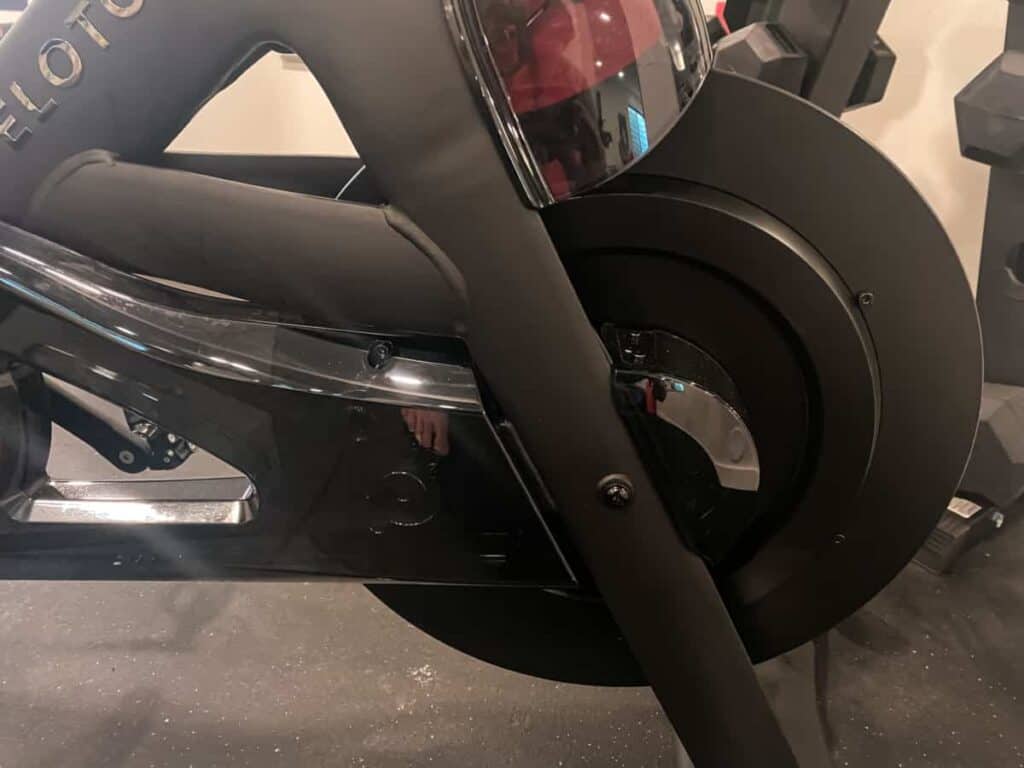Peloton bikes are increasing in popularity at a remarkable rate. The convenience that goes with having a “live” instructor helping with your home workouts is a real motivation booster. But stationary bikes are not all equal. Your bike’s flywheel is a crucial part of the effectiveness. So what is the ideal flywheel weight for you, and how heavy is the Peloton’s flywheel? Will it be sufficient?
The flywheel on a Peloton bike is 38 pounds (approximately 17 kg). On average, the flywheels of spin bikes range between 18 to 22 kg (39 to 48 pounds), so the Peloton fits this standard. But the Peloton Bike’s cable drive and magnetic resistance systems negate the importance of flywheel weight.
The weight of the flywheel on a spin bike may not affect the effectiveness of your workout much, but it has an impact on how stable your bike is, the amount of momentum required to get started, how easy your bike will be to move around, and of course, the price. Peloton bikes come with one standard weight. So, how important is the weight difference really? Let’s find out.
How Heavy Is The Peloton’s Flywheel?
The Peloton bike’s flywheel weighs 38 pounds or approximately 17 kilograms. Spinning bikes, in general, have flywheels that could range anything from 8 kilograms to 48 kilograms (18 to 105 pounds). This means that the Peloton Bike’s flywheel is perfectly average in terms of weight even though it is slightly less heavy than it could be.
Many users prefer to use a spinning bike with a heavier flywheel; this usually has added benefits like more stability while you are pedaling away your kilojoules. Unfortunately, the Peloton’s flywheel cannot be upgraded or replaced, or at least not in any authorized or approved way. Some people have done it, and there are tutorials online, but you could void your Peloton’s warranty.
What Difference Does The Weight Of The Flywheel Make on a Spin Bike?

The weight of your spinning bike’s flywheel has an impact on two levels:
Heavier Flywheels Add Stability

A stationary bike must be designed with a lot of precision. The bike itself shouldn’t take up too much space since it has to fit into your house comfortably. The Peloton Bike, for example, has a footprint of 4 feet by 2 feet. If the bike is any bigger than that, it would be inconvenient to keep in your home, and the Peloton would be limited to gyms, defeating its purpose.
The problem with a machine like a spinning bike that has such a small footprint is that it can be unstable. It’s a simple fact of physics that things get more stable as their footprint increases. That is even more important with spinning bikes since they have to take the added weight of a human, and that human will be moving on top of it the whole time.
The added momentum and weight of the person pedaling on the spinning bike could easily cause the bike to tip over, causing injury and damage. So the designers of the Peloton (and other spinning bikes) have to create a balance between a smaller footprint and the ability to maintain the bike’s balance during movement.
That’s where the flywheel comes in. The added weight of the flywheel, and its location on the bike, add stability by changing the bike’s center of gravity. With a heavier flywheel, the actual footprint of the bike doesn’t matter too much anymore.
This is why owners of spinning bikes with heavier flywheels often find that their bikes are much more stable on the floor than those with lighter flywheels. Generally speaking, the heavier the flywheel, the more stability you will have on your spinning bike.
Heavier Flywheels Make It Harder To Gain Momentum while Spinning

Anyone who’s ever been on a bike (whether stationary or an actual bicycle) will know that the first few seconds of the ride are often the hardest. That’s because the first few rotations of the pedals are often 100% due to your own effort. Unless you’re riding a real bicycle downhill, you have to exert the necessary force to get the wheels (or flywheel) turning.
Once momentum is built up, you can suddenly maintain (or even gain) speed without putting in as much effort.
The weight of the flywheel determines how easy or difficult it will be to attain this momentum on a stationary bike like the Peloton bike. Lighter flywheels are much easier to get moving than heavier flywheels, making them ideal for beginners or those who aren’t as fit yet.
Experienced spinners often prefer a heavier flywheel. The added weight leads to a more intense workout for them since the weight of the flywheel doesn’t only impact momentum in the beginning but also when you’re riding uphill. On the Peloton, the flywheel is more restrained when an uphill race is being simulated. A heavier flywheel will take more effort to get moving.
How Does The Flywheel Weight Impact The Peloton?
As mentioned, the Peloton Bike’s flywheel is on the lighter side of the weight range. Most people would assume this to mean that the bike could be slightly more unstable than others or that the workout wouldn’t be as effective. This is not true, though.
Firstly, regarding stability, Peloton positioned the flywheel on their bike a bit lower than the handlebars. This means that the center of gravity is lower, and a lower center of gravity means more stability. So despite its slightly lower weight, the design changes more than makes up for it leading to a smooth ride.
When it comes to the workout’s intensity, Peloton doesn’t use a simple belt or chain drive like other stationary bikes. The Peloton Bike uses an advanced steel-belt drive which, combined with the weight of the flywheel and magnetic resistance, makes it feel like 80 lbs, or even more, and gives it a more realistic road-bike type handling.
What Is The Best Flyweel Weight For You?
With the Peloton Bike, there is no ideal weight for you. Firstly, there is only one weight. You cannot (or should not?) replace the flywheel on the Peloton bike. But the fact is that it does not matter. Though the flywheel weight is ideal for beginner- to intermediate-level workouts, the Peloton does not rely on the weight of the flywheel as much as other bikes.
The simulated spinning workouts are designed to use the Peloton’s dynamic adjustment system that will add resistance, making the flywheel feel heavier when you’re doing an uphill segment and lighter when you’re “going downhill.”
So the critical point is not the ideal flywheel weight; it’s about choosing the proper workout for you. If you’re just starting out, don’t go for intensive simulations. Start with something more manageable to deal with and slowly work your way up from there when you’re ready.
Conclusion
The Peloton Bike may not have the heaviest flywheel, which could seem like a deterring factor if you’re considering purchasing a spinning bike. But the Peloton is still a marvel of modern engineering. It does not need a heavy flywheel to make it stable or give you a good workout. The engineers have built something incredible, so you need no longer worry about the flywheel.





